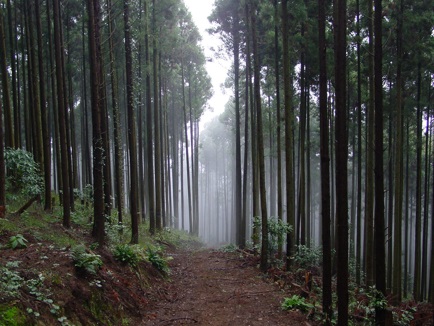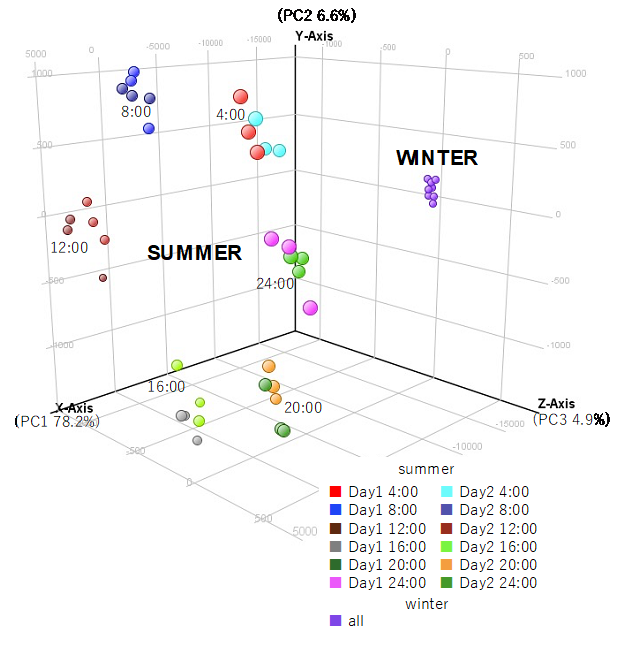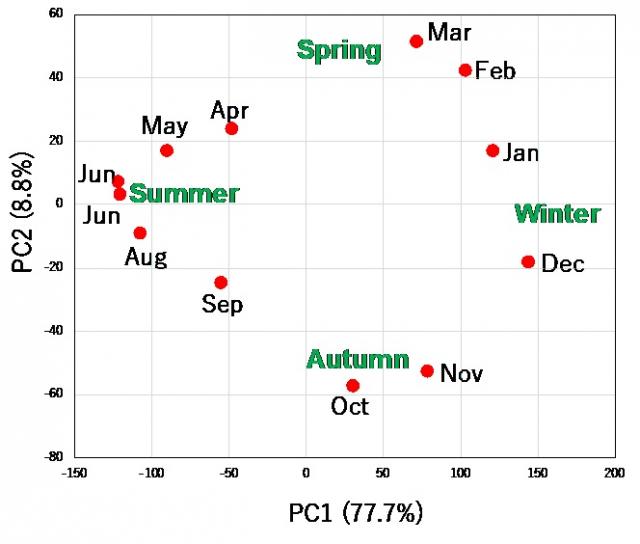Home > Research > News > Special Program for IUFRO World Day > Static event > Transcriptome Analysis of Japanese Cedar in Response to Environmental Condition Changes
Update:September 27, 2021
Main content starts here.
Transcriptome Analysis of Japanese Cedar in Response to Environmental Condition Changes
Mine Nose (Forest Tree Breeding Center)
Background
Japanese cedar (Cryptomeria japonica D. Don), a major forestry species in Japan, is distributed throughout the Japanese archipelago, which has a wide range of climatic conditions (Fig. 1). Many studies using tree height and tree ring data have reported that growth is affected by environmental conditions, but the underlying biological mechanisms remain unclear.

Fig 1. Artificial forest of Japanese cedar (Cryptomeria japonica)
Key Findings
To understand the adaptive responses to environmental changes, I study Japanese cedar trees planted in the field and under controlled environmental conditions using transcriptome analysis, such as DNA microarray and RNA-seq analysis. Transcriptome analysis is a powerful tool for elucidating molecular mechanisms. To understand adaptive responses to environmental changes over various time periods (such as 1 day or 1 year), I investigated the gene expression pattern of field-grown trees by microarray analysis. The data demonstrated clear diurnal and annual transcriptome dynamics (Figs. 2 and 3) [1, 2]. The transcriptome changes that occurred in response to environmental conditions may contribute to physiological and morphological changes. I also analyzed Japanese cedar grown under controlled conditions to identify the effect of each environmental factor, such as temperature, day length, and water conditions, and clarified which genes were related to each factor and their contribution in the field transcriptome dynamics.

Fig. 2 Diurnal transcriptome dynamics in winter and summer in Japanese cedar.
Shoot samples collected every four hours for two days in winter (December) and summer (July) were analyzed by microarray. Principal component analysis of microarray data demonstrated clear diurnal dynamics only in summer. Figure modified from Fig. 1 in [1].

Fig 3. Annual transcriptome dynamics in Japanese cedar.
Shoots samples collected throughout the year was analyzed by microarray. Principal component analysis of microarray data demonstrated dramatic annual changes in summer, but not in winter. Figure modified from Fig 1 in [2].
Future Plan
The gene expression pattern exhibited substantial variation in response to environmental changes. As physiological traits are often regulated by environmental signals, I aim to gain a deeper understanding of transcriptomic responses to environmental changes. This knowledge would enable us to select suitable clones for planting under various environmental conditions, especially in this era of climate change. It may also be possible to identify key genes that are crucial for environmental adaptation that could be exploited as markers for selecting adaptive clones or individuals.
International Perspective
Global climate change in recent years is a pressing challenge for the international community. Planting trees is one of the mitigation measures, as the trees are expected to act as a carbon sink. Ideally, we should select tree species or clones that are capable of adapting to what is expected to be a changing climate. This study may provide a fundamental understanding of and information regarding the adaptive responses to the environmental changes in coniferous species.
References
1.Nose M, Watanabe A. Clock genes and diurnal transcriptome dynamics in summer and winter in the gymnosperm Japanese cedar (Cryptomeria japonica (L.f.) D.Don). BMC Plant Biology. 2014; 14:308. https://doi.org/10.1186/s12870-014-0308-1
2.Nose M, Kurita M, Tamura M, Matsushita M, Hiraoka Y, Iki T, Hanaoka S, Mishima K, Tsubomura M, Watanabe A. Effects of day length- and temperature-regulated genes on annual transcriptome dynamics in Japanese cedar (Cryptomeria japonica D. Don), a gymnosperm indeterminate species. PLOS ONE. 2020;15(3):e0229843. https://doi.org/10.1371/journal.pone.0229843
Copyright © Forest Research and Management Organization. All rights reserved.
